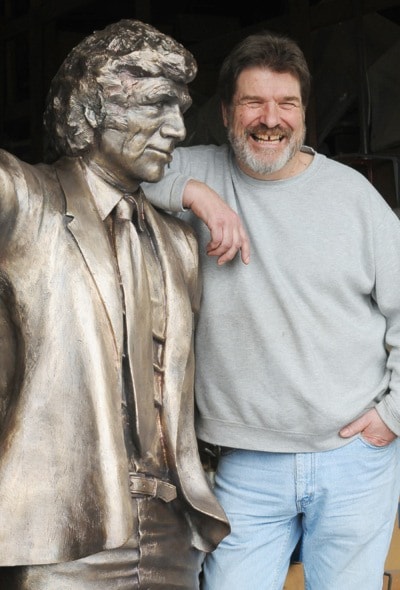A larger than life bronze statue of Roger Neilson will now greet Vancouver Canucks fans as they make their way into Rogers Arena.
The statue, which is more than 16 feet (4.9 metres) tall and weighs 800 pounds (363 kg), was set to be unveiled last night (Thursday), prior to the Canucks’ regular season home finale.
The permanent outdoor tribute was part of the Canucks’ 40th anniversary celebrations, as they spent the night honouring the former coach who first led the team to the Stanley Cup finals.
The statue, cast in Langley, is located on the North Plaza outside Rogers Arena, on the corner of Expo Boulevard and Abbott Street.
Neilson was inducted into the Hockey Hall of Fame’s builder category in 2002.
He passed away the following year at the age of 69.
Neilson earned a spot in Canucks lore during the 1982 playoffs.
With what he perceived as questionable officiating from the referees against his team during the Campbell Conference championship series against the Chicago Blackhawks, Neilson grabbed one of his players’ sticks and hung a towel off the end, waving it in mock surrender.
Those actions got him tossed from the game, but when the team arrived back at the Pacific Coliseum for the series’ next game, the Canucks were greeted by thousands of white-towel waving fans. The ‘Towel Power’ tradition was born in Vancouver and to this day fans wave white towels during the playoffs, a tradition picked up by several other teams as well.
The artist commissioned to create the piece, Norm Williams, remembers watching the incident against Chicago on TV.
“It gives you a feel for things,” he said about having a connection to the incident.
“When you can remember the incident, know what led up to it, know how he is feeling from all the stories and the history and what kind of guy he was, that all helps,” Williams said.
“If I was a stranger to this, I would not have gotten an accurate reflection of him.”
Williams, a 67-year-old from Abbotsford, has followed the Canucks since before they even joined the NHL in 1970.
He was chosen for the project last spring, and since then he estimates he has put 1,200 hours into the work.
“The hardest parts were getting good pictures to work from,” Williams said.
Since this was before the digital age, Williams did not have thousands of images to choose from. The ones he could look at where either from too far a distance or didn’t reveal any emotion on his face.
“You need photographs where you can really see details on the guy, like lines in the face and find expressions and some candid poses,” Williams said.
“I wanted him to look exasperated, (so) I had to rely on what I knew about him and remembered about him.”
Williams remembered Neilson having a wrinkled brow and bushy eyebrows.
“You had to have some indication of that and some indication of how he chewed his lip from the inside,” Williams added. “It is quite the challenge fitting it altogether and making it right because there are people who will know and will call you on it if you are wrong.”
The initial work, with which an assistant helped him for about five weeks, was done at Williams’ studio in Abbotsford.
Neilson’s head and hands were made out of clay — getting the face just right took multiple tries — and then set in plaster.
The body was moulded directly in plaster.
Once that was completed, Williams transported the plaster statue to In Bronze, a fine art bronze casting foundry in Langley four months ago.
Here it was transformed from its mould into the final finished piece.
The end result was a seven-foot statue of Neilson, wearing a suit and tie, with his left hand tucked into his jacket pocket. The right hand is raised above his head with a towel draped over the end. It stands nearly 12 and half feet, and will be placed on top of a four-foot base.
